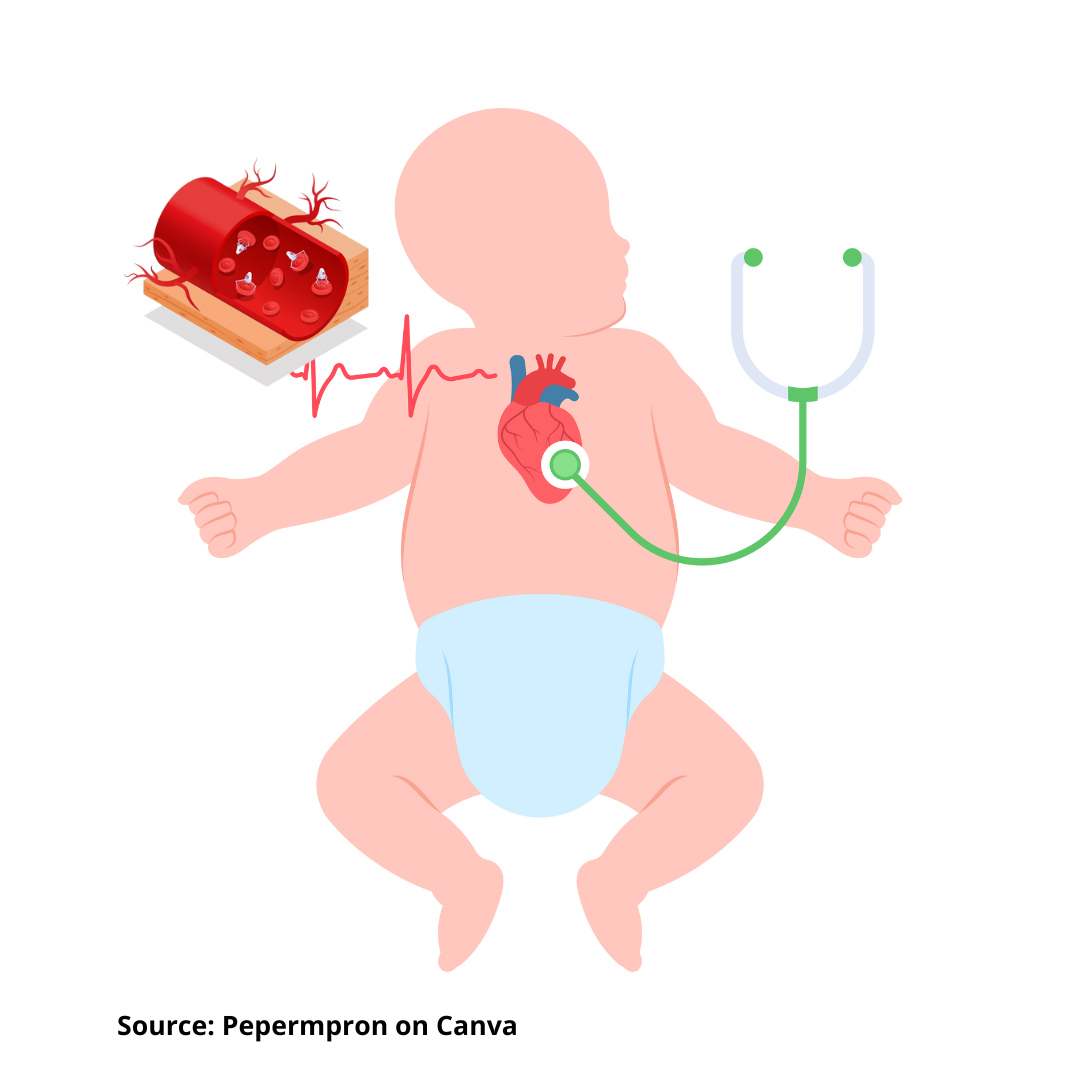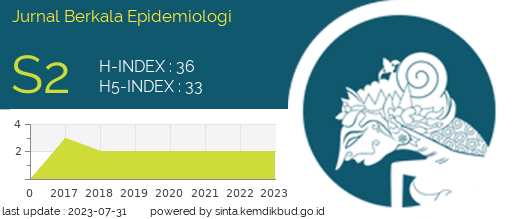DETERMINANT FACTORS FOR CENTRAL LINE-ASSOCIATED BLOOD STREAM INFECTIONS (CLABSI) IN NEONATES
Faktor Determinan Central Line-Associated Blood Stream Infections (CLABSI) Pada Neonatus

Downloads
Background: CLABSI accounts for 70% of all hospitalized bloodstream infections, especially in premature infants. CLABSI in neonates can compromise the immune system and future quality of life. Purpose: This study aims to identify determinant factors associated with CLABSI in neonates. Methods: This research was a scoping review study of three international databases namely Science Direct, PubMed, and ProQuest from January 2021-April 2024. Keyword selection refers to PCC (Populations, Concepts, Categories), with the keywords used "factor" AND "associated" AND "CLABSI" AND ("neonate" OR "newborn") AND "hospital." The selection process is depicted with PRISMA-ScR. Results: A total of 14 articles met the criteria and objectives of the study. The articles obtained represented all continents, which were conducted in the Americas (29%), Europe (29%), Asia (29%), and Africa (13%). Risk factors for CLABSI in neonates are grouped into two, namely intrinsic and extrinsic factors. Prevention of CLABSI in neonates can be done by modifying extrinsic factors, namely with proper aseptic technique, supervision, and management strategies. Conclusion: The determinant factors of CLABSI in neonates include intrinsic factors (gestational age of <27 weeks or preterm, comorbidities, being born by cesarean section, low birth weight, being previously treated with antibiotics, and having underlying surgical conditions) and extrinsic factors (the type of catheter, the amount of catheter lumen, long duration of insertion, insertion location at the femoral and internal-jugular access site, parenteral nutrition, and large microbial colonization at the insertion site).
CDC. Central Line-Associated Bloodstream Infection (CLABSI): an introduction. 2016.
Xu B, Zhang J, Hou J, Ma M, Gong Z, Tang S. Nurses’ attitudes and knowledge of peripherally inserted central catheter maintenance in primary hospitals in China: a cross-sectional survey. Risk Manag Healthc Policy. 2020;13:903–13.
Patel PR, Weiner-Lastinger LM, Dudeck MA, Fike L V., Kuhar DT, Edwards JR, et al. Impact of COVID-19 Pandemic on central-line-associated bloodstream infections during the early months of 2020, national healthcare safety network. Infect Control Hosp Epidemiol. 2021;15:1–4.
Toor H, Farr S, Savla P, Kashyap S, Wang S, Miulli DE. Prevalence of Central Line-Associated Bloodstream Infections (CLABSI) in intensive care and medical-surgical units. Cureus. 2022;14(3):1–7.
Alshahrani KM, Alhuwaishe AZ, Alangari NM, Asiri MA, Al-Shahrani NA, Alasmari AA, et al. Clinical impacts and risk factors for central line-associated bloodstream infection: a systematic review. Cureus. 2023;15(6):1–12.
McBeth CL. Scrub the Hub:: CLABSI prevention through nurse leader, staff engagement. Nurse Lead. 2020;18(2):116–9.
CDC. Data summary: assessing progress 2006-2016. 2017.
Raskita RY, Ristica OD. Midwifery care for newborns with neonatal visits – iii at Arrabih Primary Clinic, Pekanbaru City 2022. Curr Midwifery J. 2022;2(2):280–7.
Hollins BJ. Infection control: reducing hospital acquired central line bloodstream infections. University of San Francisco; 2017.
Hussain AS, Ahmed AM, Arbab S, Ariff S, Ali R, Demas S, et al. Clabsi reduction using evidence based interventions and nurse empowerment: a quality improvement initiative from a tertiary care NICU in Pakistan. Arch Dis Child. 2021;106(4):394–400.
García H, Romano-Carro B, Miranda-Novales G, González-Cabello HJ, Núñez-Enríquez JC. Risk factors for central line-associated bloodstream infection in critically ill neonates. Indian J Pediatr. 2019;86(4):340–6.
JCI. CLABSI Toolkit - Chapter 1. 2013.
Nielsen CL, Zachariassen G, Holm KG. Central line-associated bloodstream infection in infants admitted to a level lllneonatal intensive care unit. Dan Med J. 2022;7(69).
Hussain AS, Ahmed AM, Arbab S, Ariff S, Ali R, Demas S, et al. CLABSI reduction using evidence based interventions and nurse empowerment: a quality improvement initiative from a tertiary care NICU in Pakistan. Arch Dis Child. 2020;0:1–7.
Durant DJ, Fallwell N, Martinez L, Guerrazzi-Young C. Is central line type an independent risk factor of central line-associated bloodstream infection in a neonatal intensive care unit population? Experiences at a pediatric hospital in South Texas. Antimicrob Steward Healthc Epidemiol. 2024;4(e16):1–6.
Jarraya A, Kammoun M, Chtourou A, Ammar S, Kolsi K. Complications and its risk factors of percutaneous subclavian vein catheters in pediatric patients: enhancing the outcomes of a university hospital in a low-income and middle-income country. World J Pediatr Surg. 2023;6(1):1–6.
Dramowski A, Bekker A, Cotton MF, Whitelaw AC, Coffin S. Epidemiology of Clinically Suspected and Laboratory-Confirmed Bloodstream Infections at a South African Neonatal Unit. J Infect Dev Ctries. 2021;15(7):943–952.
Zhang L, LiuYang, Dong W, Liu X, Lei X, Zhang L. Risk factors and clinical analysis of peripherally inserted central catheter related fungal colonization in premature infants. Sci Reports. 2021;11(1).
Hu Y, Ling Y, Ye Y, Zhang L, Xia X, Jiang Q, et al. Analysis of risk factors of picc-related bloodstream infection in newborns: implications for nursing care. Eur J Med Res. 2021;26(1).
Khieosanuk K, Fupinwong S, Tosilakul A, Sricharoen N, Sudjaritruk T. Incidence rate and risk factors of central line-associated bloodstream infections among neonates and children admitted to a tertiary care university hospital. Am J Infect Control. 2022;50(1):105–7.
Jansen SJ, Broer SDL, Hemels MAC, Visser DH, Antonius TAJ, Heijting IE, et al. Central-line-associated bloodstream infection burden among dutch neonatal intensive care units. J Hosp Infect. 2024;144:20–7.
Picaud JC, Faton S, Pradat P, Pastor-Diez B, Martelin A, Armoiry X, et al. A new perfusion system to reduce the burden of central-venous-line-associated bloodstream infections in neonates. J Hosp Infect. 2024;143:203–12.
Durant DJ, Guerrazzi-Young C, Martinez L, Fallwell N. Risk factors for central line-associated bloodstream infection in a nicu population: experiences at a pediatric hospital in South Texas. Am J Infect Control. 2023;51(7).
Catho G, Mangeret FR, Sauvan V, Chraı¨ti MN, Pfister R, Baud O, et al. Risk of catheter-associated bloodstream infection by catheter type in a neonatal intensive care unit: a large cohort study of more than 1100 intravascular catheters. J Hosp Infect. 2023;139:6–10.
Rosenthal VD, Jin Z, Valderrama-Beltran SL, Carreazo NY, Salgado E, Yin R. Multinational prospective cohort study of incidence and risk factors for central line-associated bloodstream infections in ICUs of 8 Latin American countrie. Am J Infect Control. 2023;51(10):1114–9.
Torres-Muñoz J, Hoyos IV, Murillo J, Holguin J, Dávalos D, López E, et al. Device-Associated Infections in Neonatal Care Units in a Middle-Income Country, 2016-2018. J Pediatr (Rio J). 2023;99(5):485–91.
Alotaibi NH, Barri A, Elahi MA. Length of stay in patients with central line-associated bloodstream infection at a tertiary hospital in the Kingdom of Saudi Arabia. Cureus. 2020;12(10):1–7.
Sudana A, Santoso EB, Pamungkas P. Post-CVC insertion infection incidents due to parenteral nutrition administration and length of CVC use. JIK J Ilmu Keperawatan. 2023;1(1):33–40.
- Every manuscript submitted to must observe the policy and terms set by the Jurnal Berkala Epidemiologi
- Publication rights to manuscript content published by the Jurnal Berkala Epidemiologi is owned by the journal with the consent and approval of the author(s) concerned. (download copyright agreement)
- Complete texts of electronically published manuscripts can be accessed free of charge if used for educational and research purposes according to copyright regulations.

JBE by Universitas Airlangga is licensed under a Creative Commons Attribution-ShareAlike 4.0 International License.























